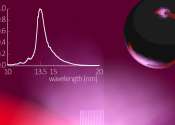Quantum hall effect 'reincarnated' in 3-D topological materials
U.S. and German physicists have found surprising evidence that one of the most famous phenomena in modern physics—the quantum Hall effect—is "reincarnated" in topological superconductors that could be used to build fault-tolerant ...









